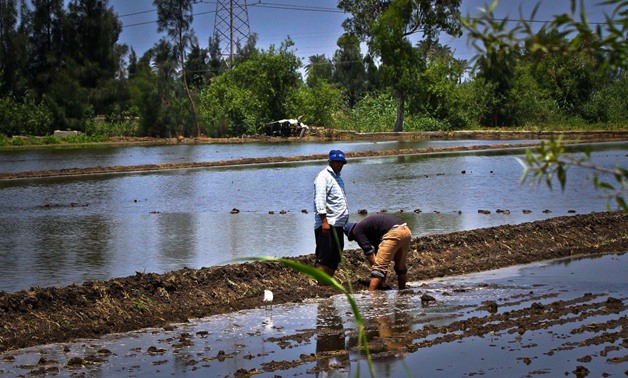
FILE- Egyptian farmers cultivate rice- Egypt Today/Hussein Tallal
CAIRO – 5 July 2018: After being a rice exporter, Egypt will turn into an importer following the governmental measures reducing the rice-cultivated areas due to the water shortage crisis the country is suffering from.
Prime Minister Moustafa Madbouly and Minister of Supply and Interior Trade Ali Meselhi will discuss on Thursday the possibility of importing rice, one of the basic commodities for Egyptians, to meet the local market’s demands, according to a statement issued from the Cabinet on Thursday.
On May 21, President Abdel Fatah al-Sisi ratified the newly-passed amendments to the Agriculture Law No. 53 of 1966, per which the government will determine the areas to cultivate certain water-intensive crops such as rice and sugarcane, amid the water shortage crisis in order to rationalize water usage.
Also, Article 101 of the law stipulates that those who violate the ministerial decrees issued to implement Articles 1, 2, 3, and 4 of the Agriculture Law shall be punished with a fine not less than LE 20,000 (about $1,119) and not more than LE 50,000.
On May 2, the Egyptian government agreed to increase the area allocated for rice cultivation by 100,000 feddans (one feddan equals 1.038 acres) for this season only, bringing the total area allocated for rice cultivation to 820,000 feddans, Abdel Latif Khaled, head of irrigation sector in the Ministry of Irrigation and Water Resources stated.
Thus, it is expected that Egypt will produce about 3.3 million tons this year as one feddan produces 4 tons, while the Egyptians’ annual consumption of rice is estimated at 4.3 million tons.
However, the cultivated areas will be shrunk in the coming seasons as a result of water scarcity, given that one feddan of rice consumes 7,000 cubic meters of water.
Egypt needs at least 105 billion cubic meters of water annually to cover the needs of more than 90 million citizens. However, it currently has only 60 billion cubic meters, of which 55.5 billion cubic meters come from the Nile and less than 5 billion cubic meters come from non-renewable subterranean water in the desert. The remaining 80 billion cubic meters are covered by the reuse of wastewater. The average per capita consumption of fresh water declined by 1.5 percent in 2015/2016 as it reached 103.4 cubic meters, compared to 105 cubic meters in 2015/2014, according to the Central Agency for Public Mobilization and Statistics (CAPMAS) data.
A further decrease in Egypt's water resources is expected in light of the construction of the Grand Ethiopian Renaissance Dam (GERD), which could have a negative impact on Egypt’s Nile water share.
Officially, the government announced its plan to import rice (paddy, mulled and cargo rice) on June 5. After Egypt’s announcement, the U.S. Department of Agriculture (USDA) issued a report on Egypt’s rice production, promoting the U.S.-origin paddy rice.
Egypt was the largest rice producer in the Near East region, according to the FAO data in 2004. In the period between 2015 and 2016, the country exported rice with a revenue of $58 million. However, rice export was banned in August 2016 to meet the local demand after shrinking the cultivated areas.

Comments
Leave a Comment